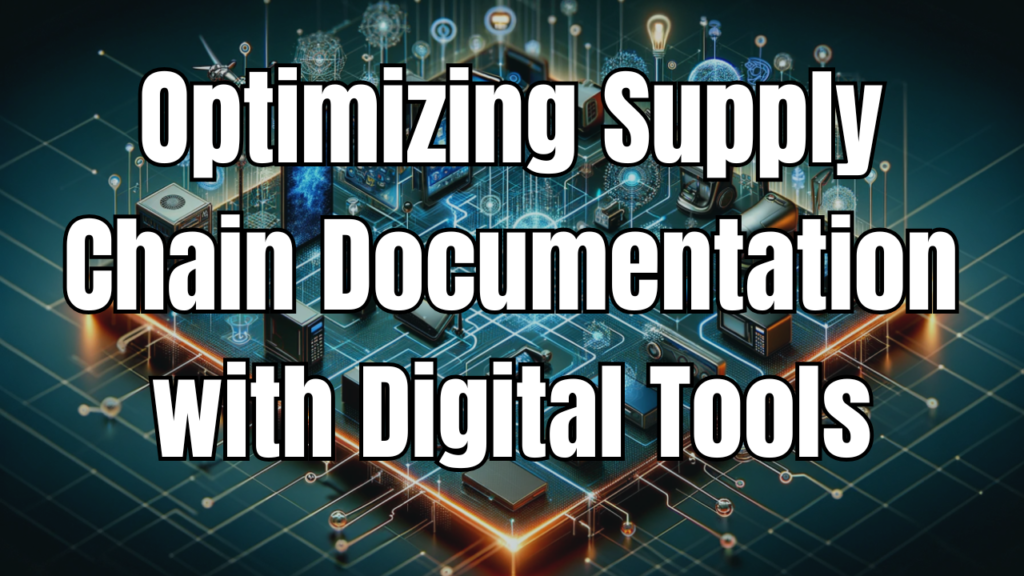Key Takeaways
- Effective documentation is crucial for supply chain success.
- Traditional methods can cause costly errors and delays.
- Digital tools enhance workflow automation and collaboration.
- PDF tools streamline documentation with versatile features.
- Implementing digital solutions boosts efficiency and saves costs.
Effective documentation is pivotal in supply chain administration because it guarantees the exact following of items, opportune communication between partners, and compliance with administrative prerequisites. In a progressively complex and fast-paced worldwide showcase, conventional documentation strategies frequently drop brief, leading to delays and mistakes that can essentially affect operations. Computerized devices have developed as imperative resources in streamlining these forms, upgrading collaboration, and moving forward by and large effectiveness.
The Part of Documentation in Supply Chain Administration

Documentation is the spine of supply chain administration, including an assortment of basic records that encourage the stream of products and data. Key types of reports included within the supply chain incorporate:
- Solicitations: These are demands for installment issued by providers to buyers, specifying the merchandise or administrations given, their amounts, costs, and installment terms.
- Contracts: Assents between parties that diagram the terms and conditions of exchanges, counting estimating, conveyance plans, and duties.
- Shipping Archives: This category incorporates bills of filling, pressing records, and traditional statements that guarantee products are transported legitimately and effectively.
- Buy Orders: Official reports sent from a buyer to a vendor, indicating sorts, amounts, and concurred costs for items or administrations.
- Stock Records: Archives that track stock levels, make a difference in businesses, and oversee their supply chain operations viably.
The precision, openness, and organization of these archives are basic for the victory of supply chain operations. Precise documentation makes a difference in anticipating debate and blunders that can lead to money-related misfortunes and operational delays. Availability guarantees that partners can recover vital data rapidly, encouraging opportune decision-making. Besides, organized documentation permits for consistent following of items and compliance with administrative necessities, eventually upgrading operational effectiveness.
In any case, conventional documentation strategies show a few challenges. Manual forms are inclined to human blunders, such as information entry mistakes or misfiled records, which can disturb the whole supply chain. The time-consuming nature of paper-based documentation can lead to delays in handling exchanges and communication. Furthermore, the physical capacity of archives poses issues related to space, availability, and the hazard of misfortune due to harm or removal.
Benefits of Advanced Devices in Supply Chain Documentation
The selection of advanced tools in supply chain documentation improves the productivity and exactness of forms and cultivates way better collaboration among partners, driving considerably a toll on reserve funds.
Diagram of How Advanced Instruments Change Documentation Forms
Advanced tools have revolutionized the way supply chain documentation is made, overseen, and shared. Conventional documentation strategies regularly include manual forms that can be time-consuming and inclined to blunders. In differentiation, advanced tools empower mechanization and streamline workflows, coming about in quicker handling times and progressed precision. For occasion, a robotized information section decreases the chance of human mistake, whereas archive administration frameworks permit for simpler recovery and organization of records.
Upgrades in Collaboration and Communication Over the Supply Chain
Viable communication is basic in supply chain administration, where different stakeholders from providers to distributors must work together consistently. Advanced tools encourage real-time collaboration by empowering partners to get to and alter archives at the same time, notwithstanding of their area. Stages such as cloud-based report-sharing frameworks permit moment upgrades and notices, guaranteeing that everybody is on the same page. Also, coordinated communication tools (e.g., chat and video conferencing) can be connected specifically to documentation, advancing prompt dialogs and choices based on the most recent information.
Cost Savings and Efficiency Improvements
Actualizing computerized devices in supply chain documentation can result in critical taking a toll on reserve funds and productivity advancements. By decreasing dependence on paper-based forms, organizations can lower printing and capacity costs while minimizing the natural effect. Moreover, mechanized workflows diminish the time that goes through manual errands, permitting workers to center on more key exercises. For case, utilizing PDF devices to change over, consolidate, or alter reports can streamline the report era and encourage speedier decision-making.
PDF tools: A Key Component of Documentation Optimization

By understanding when and why to change over reports, organizations can use these groups to move forward their documentation hones and upgrade communication over the supply chain.
A. Presentation to PDF Instruments in Supply Chain Documentation
PDF tools play a significant part in optimizing supply chain documentation by giving usefulness that upgrades effectiveness, exactness, and collaboration. PDF tools support supply chain administration by ensuring all stakeholders can easily access and use essential documents. With features like editing, merging, splitting, and converting, these tools help companies maintain a well-organized document workflow. This structure enhances operational efficiency across the supply chain.
B. Combining and Part PDFs
Combining numerous reports into a single PDF is a basic highlight for making streamlined reports and solidified records. In supply chain administration, documentation frequently comes from different sources, such as buy orders, shipping solicitations, and conveyance affirmations. By combining these reports, companies can display a comprehensive see of exchanges, which disentangles audit forms and improves communication with partners.
On the other hand, part huge PDFs into smaller, more sensible parts can altogether progress report organization. For occurrence, long contracts or point-by-point reports may be lumbering for group individuals to explore. By breaking these reports into sections such as terms, estimating, or legitimate clauses users can center on particular ranges of intrigued without swimming through unessential data. This focused approach not as it were improves clarity but too moves forward in general efficiency, as people can rapidly find the data they require.
C. Converting PDFs to Other Groups
The capacity to change PDFs to different formats such as Word, Excel, PowerPoint, JPG, JSON, and XML adds a layer of adaptability that’s crucial for different partners within the supply chain. Each organization serves particular purposes that can improve workflow effectiveness. For illustration:
- Word: Changing over a PDF to Word permits for simple altering of text-heavy reports, such as contracts or arrangement manuals, making it easier to upgrade terms and conditions without beginning from scratch.
- Excel: Changing PDF information into Excel is especially advantageous for information examination. Supply chain supervisors can control and analyze numerical information more viably, supporting in determining and stock administration.
- PowerPoint: When planning introductions for partners, changing PDFs to PowerPoint empowers the consistent joining of visual components and information, guaranteeing that key focuses are passed on successfully.
- JPG: Converting to JPG organize is valuable for sharing product pictures or graphical substance. This is often particularly significant in promoting materials or online catalogs.
- JSON/XML: These groups are significant for information compatibility between frameworks. Changing PDFs to JSON or XML can encourage integration with computer program applications, upgrading robotized forms inside supply chain administration.
Final Thoughts
Optimizing supply chain documentation through digital tools is crucial for improving operational efficiency and accuracy in today’s complex market. Compelling documentation guarantees convenient access to basic data for all partners. These computerized arrangements not only encourage superior communication over the supply chain but moreover lead to noteworthy taken a toll reserve funds and efficiency changes.







More Stories
PIXMA TR4722: Can’t Connect Wirelessly – Troubleshooting and Solutions
Why India is the Go-To Destination for Customized Software Development
How Website Speed Impacts Your Business: A Guide for USA Companies